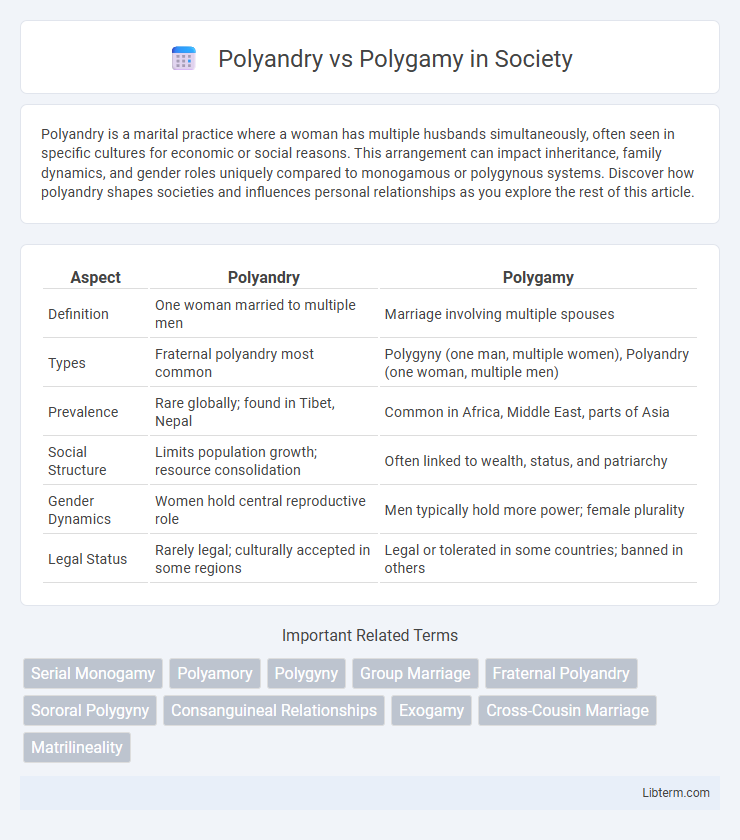Polyandry is a marital practice where a woman has multiple husbands simultaneously, often seen in specific cultures for economic or social reasons. This arrangement can impact inheritance, family dynamics, and gender roles uniquely compared to monogamous or polygynous systems. Discover how polyandry shapes societies and influences personal relationships as you explore the rest of this article.
Table of Comparison
| Aspect | Polyandry | Polygamy |
|---|---|---|
| Definition | One woman married to multiple men | Marriage involving multiple spouses |
| Types | Fraternal polyandry most common | Polygyny (one man, multiple women), Polyandry (one woman, multiple men) |
| Prevalence | Rare globally; found in Tibet, Nepal | Common in Africa, Middle East, parts of Asia |
| Social Structure | Limits population growth; resource consolidation | Often linked to wealth, status, and patriarchy |
| Gender Dynamics | Women hold central reproductive role | Men typically hold more power; female plurality |
| Legal Status | Rarely legal; culturally accepted in some regions | Legal or tolerated in some countries; banned in others |
Understanding Polyandry and Polygamy: Key Definitions
Polyandry is a form of marriage in which a woman has multiple husbands simultaneously, while polygamy broadly encompasses any marriage involving more than two partners, including both polygyny (one man with multiple wives) and polyandry. Polyandry remains rare globally and is mostly found in specific cultures such as those in Tibet, Nepal, and parts of India, whereas polygyny is more widely practiced in regions across Africa, the Middle East, and Southeast Asia. Understanding these key definitions helps clarify the social, cultural, and legal distinctions between diverse marital structures worldwide.
Historical Origins of Polyandry and Polygamy
Polyandry and polygamy have distinct historical origins rooted in cultural, economic, and social factors. Polyandry, primarily documented in Tibetan and certain Himalayan societies, emerged as a strategy to preserve limited arable land and resources by preventing the division of family estates among multiple heirs. Polygamy, historically widespread across African, Middle Eastern, and some Asian cultures, often served to enhance social status, labor forces, and political alliances through multiple marriages, predominantly polygyny where one man has multiple wives.
Geographic Distribution and Prevalence
Polyandry is primarily found in regions of the Himalayas, parts of Tibet, and Nepal, where it is practiced among certain ethnic groups such as the Sherpas and Toda for socioeconomic and environmental reasons. Polygamy, especially polygyny, is more widespread, prevalent in parts of Africa, the Middle East, and among some Polynesian cultures, often influenced by religious and cultural traditions. Globally, polygamy remains more common and legally recognized in comparison to polyandry, which is culturally rare and geographically limited.
Cultural and Religious Influences
Polyandry and polygamy are shaped by distinct cultural and religious influences, with polyandry predominantly found in specific Himalayan societies like Tibet, where fraternal polyandry preserves family land and resources. Polygamy, especially polygyny, is more widespread in various African, Middle Eastern, and Muslim-majority countries, often rooted in Islamic and traditional customs that permit multiple wives for social or economic reasons. Religious texts such as the Quran explicitly regulate polygyny, while polyandry lacks widespread religious endorsement, reflecting differing societal norms and spiritual interpretations.
Social Dynamics in Polyandrous and Polygamous Families
Social dynamics in polyandrous families often center on cooperative resource management and shared child-rearing responsibilities among multiple husbands, fostering a collective approach to family stability. In polygamous families, particularly polygynous ones, social interactions typically involve hierarchical relationships where one husband manages multiple wives, which can influence power dynamics and resource distribution. Both family structures impact kinship networks differently, with polyandry promoting fraternal alliances and polygamy expanding social connections across multiple marriages.
Economic Motivations and Consequences
In polyandry, economic motivations often include the consolidation of family wealth and land, reducing division of property among heirs and ensuring financial stability. Polygamy can lead to increased household labor and resource pooling but may strain economic resources due to higher demands for provisioning multiple spouses and offspring. Both systems reflect adaptation to environmental and socio-economic pressures influencing inheritance, labor distribution, and social status within communities.
Gender Roles and Power Structures
Polyandry, where one woman has multiple husbands, challenges traditional gender roles by concentrating reproductive authority and economic power in female hands, often promoting egalitarian power structures within the family. Polygamy, particularly polygyny where one man has multiple wives, reinforces patriarchal systems by placing men in dominant positions of authority and control over resources and decision-making. These marriage systems reflect and perpetuate distinct social hierarchies, with polyandry often linked to resource scarcity and communal cooperation, while polygamy aligns with male dominance and wealth accumulation.
Legal Status and Human Rights Issues
Polyandry, the practice of a woman having multiple husbands, is legally prohibited in most jurisdictions, whereas polygamy, typically polygyny involving one man and multiple wives, remains legally recognized in certain countries primarily in the Middle East, Africa, and South Asia. International human rights organizations highlight concerns such as gender inequality, consent, and potential exploitation in both arrangements, advocating for legal frameworks that prioritize individual freedoms and gender equity. Legal challenges often center on marital rights, inheritance, and the protection of women and children within these non-monogamous unions.
Contemporary Trends and Changes
Contemporary trends reveal a decline in traditional polygamous arrangements, with increasing recognition of polyandry, particularly in regions facing demographic imbalances or resource scarcity. Sociocultural shifts and legal reforms are fostering more diverse family structures, reflecting evolving gender roles and economic factors. Research highlights growing acceptance in urban settings, driven by empowerment movements and changing marriage norms.
Future Perspectives on Polyandry and Polygamy
Future perspectives on polyandry and polygamy reveal shifting cultural norms influenced by globalization, legal reforms, and evolving gender roles. Increased research emphasizes polyandry's potential in resource-scarce environments and polygamy's adaptation within modern family structures. Technological advancements and social acceptance continue shaping diverse marital practices, reflecting complex socio-economic dynamics worldwide.
Polyandry Infographic

 libterm.com
libterm.com